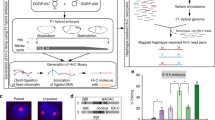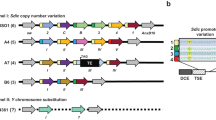Abstract
Clustering of co-expressed, non-homologous genes on chromosomes implies their co-regulation. In lower eukaryotes, co-expressed genes are often found in pairs1,2. Clustering of genes that share aspects of transcriptional regulation has also been reported in higher eukaryotes3,4. To advance our understanding of the mode of coordinated gene regulation in multicellular organisms, we performed a genome-wide analysis of the chromosomal distribution of co-expressed genes in Drosophila. We identified a total of 1,661 testes-specific genes, one-third of which are clustered on chromosomes. The number of clusters of three or more genes is much higher than expected by chance. We observed a similar trend for genes upregulated in the embryo and in the adult head, although the expression pattern of individual genes cannot be predicted on the basis of chromosomal position alone. Our data suggest that the prevalent mechanism of transcriptional co-regulation in higher eukaryotes operates with extensive chromatin domains that comprise multiple genes.
This is a preview of subscription content, access via your institution
Access options
Subscribe to this journal
Receive 51 print issues and online access
$199.00 per year
only $3.90 per issue
Buy this article
- Purchase on Springer Link
- Instant access to full article PDF
Prices may be subject to local taxes which are calculated during checkout



Similar content being viewed by others
References
Cohen, B. A., Mitra, R. D., Hughes, J. D. & Church, G. M. A computational analysis of whole-genome expression data reveals chromosomal domains of gene expression. Nature Genet. 26, 183–186 (2001)
Cho, R. J. et al. A genome-wide transcriptional analysis of the mitotic cell cycle. Mol. Cell 2, 65–73 (1998)
Lercher, M. J., Urrutia, A. O. & Hurst, L. D. Clustering of housekeeping genes provides a unified model of gene order in the human genome. Nature Genet. 31, 180–183 (2002)
Ueda, H. R. et al. Genome-wide transcriptional orchestration of circadian rhythms in Drosophila. J. Biol. Chem. 277, 14048–14052 (2002)
Meller, V. H. Dosage compensation: making 1X equal 2X. Trends Cell Biol. 10, 54–59 (2000)
Akhtar, A. & Becker, P. B. Activation of transcription through histone H4 acetylation by MOF, an acetyltransferase essential for dosage compensation in Drosophila. Mol. Cell 5, 367–375 (2000)
Smith, E. R. et al. The Drosophila MSL complex acetylates histone H4 at lysine 16, a chromatin modification linked to dosage compensation. Mol. Cell Biol. 20, 312–318 (2000)
Bhadra, U., Pal-Bhadra, M. & Birchler, J. A. Role of the male specific lethal (msl) genes in modifying the effects of sex chromosomal dosage in Drosophila. Genetics 152, 249–268 (1999)
Spellman, P. T. & Rubin, G. M. Evidence for large domains of similarly expressed genes in the Drosophila genome. J. Biol. 1, 5 (2002)
Roy, P. J., Stuart, J. M., Lund, J. & Kim, S. K. Chromosomal clustering of muscle-specific genes in Caenorhabditis elegans. Nature 418, 975–979 (2002)
Kramer, J. A., McCarrey, J. R., Djakiew, D. & Krawetz, S. A. Differentiation: the selective potentiation of chromatin domains. Development 125, 4749–4755 (1998)
Wynn, S. L. et al. Organization and conservation of the GART/SON/DONSON locus in mouse and human genomes. Genomics 68, 57–62 (2000)
Soury, E. et al. Chromosomal assignment of mammalian genes with an acute inflammation-regulated expression in liver. Imunogenetics 53, 634–642 (2001)
Kramer, J. A., McCarrey, J. R., Djakiew, D. & Krawetz, S. A. Human spermatogenesis as a model to examine gene potentiation. Mol. Reprod. Dev. 56, 254–258 (2000)
Schübeler, D. et al. Nuclear localization and histone acetylation: a pathway for chromatin opening and transcriptional activation of the human β-globin locus. Genes Dev. 14, 940–950 (2000)
Elefant, F., Cooke, N. E. & Liebhaber, S. A. Targeted recruitment of histone acetyltransferase activity to a locus control region. J. Biol. Chem. 275, 13827–13834 (2000)
Brown, C. E., Lechner, T., Howe, L. A. & Workman, J. L. The many HATs of transcription coactivators. Trends Biochem. Sci. 25, 15–19 (2000)
Kingston, R. E. & Narlikar, G. J. ATP-dependent remodeling and acetylation as regulators of chromatin fluidity. Genes Dev. 13, 2339–2352 (1999)
Corona, D. F., Clapier, C. R., Becker, P. B. & Tamkun, J. W. Modulation of ISWI function by site-specific histone acetylation. EMBO Rep. 3, 242–247 (2002)
Meiklejohn, C. D., Parsch, J., Ranz, J. M. & Hartl, D. L. 43rd Ann. Drosophila Research Conference, Abstract 112 40 (The Genetics Society of America, Bethesda, 2002)
Parisi, M. J., et al. 43rd Ann. Drosophila Research Conference, Abstract 46 17 (The Genetics Society of America, Bethesda, 2002)
Smith, E. R., Allis, C. D. & Lucchesi, J. C. Linking global histone acetylation to the transcription enhancement of X-chromosomal genes in Drosophila males. J. Biol. Chem. 276, 31483–31486 (2001)
Acknowledgements
This work was supported by a grant from the US Public Health Service. We thank D. Albertini, E. Gibney, M. Nurminskaya and V. Shkadov for their comments and careful reading of the manuscript.
Author information
Authors and Affiliations
Corresponding author
Ethics declarations
Competing interests
The authors declare that they have no competing financial interests.
Rights and permissions
About this article
Cite this article
Boutanaev, A., Kalmykova, A., Shevelyov, Y. et al. Large clusters of co-expressed genes in the Drosophila genome. Nature 420, 666–669 (2002). https://doi.org/10.1038/nature01216
Received:
Accepted:
Issue Date:
DOI: https://doi.org/10.1038/nature01216
This article is cited by
-
Gene function prediction in five model eukaryotes exclusively based on gene relative location through machine learning
Scientific Reports (2022)
-
Evolutionary and functional patterns of shared gene neighbourhood in fungi
Nature Microbiology (2019)
-
QTL analysis of cocoon shell weight identifies BmRPL18 associated with silk protein synthesis in silkworm by pooling sequencing
Scientific Reports (2017)
-
Histone modifications facilitate the coexpression of bidirectional promoters in rice
BMC Genomics (2016)
-
Map of open and closed chromatin domains in Drosophila genome
BMC Genomics (2014)
Comments
By submitting a comment you agree to abide by our Terms and Community Guidelines. If you find something abusive or that does not comply with our terms or guidelines please flag it as inappropriate.



